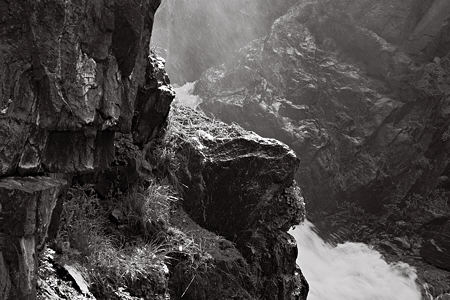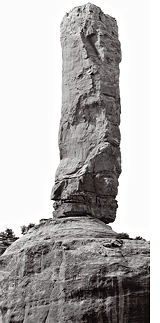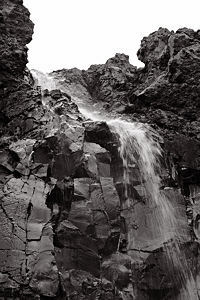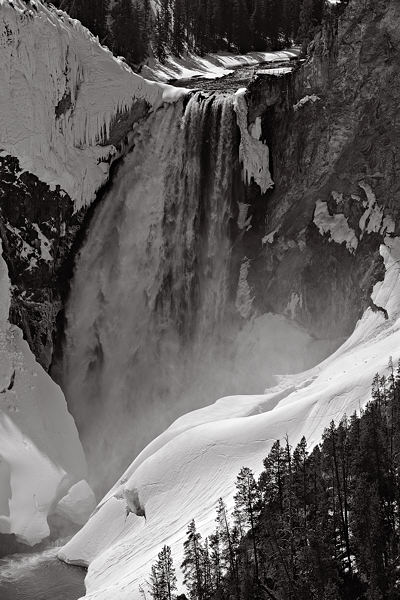Posted by Steve Durbin on July 3rd, 2007

As regular readers may know, I’ve been intrigued by resemblances noted between some of my photographs, particularly the recent waterfall series, and those of Clyfford Still, the eccentric Abstract Expressionist determined to go his own way, living most of his life in relative isolation from the art world. Over the last year or so, I have sensed some movement toward abstraction in my work and I would like to explore that. What is abstraction for me? How does it relate to representation? What and how does it mean? I’m not aiming for a more sophisticated Statement, I’m just trying to better understand what I do and what others have done and what I can learn from it.
more… »
Posted by Arthur Whitman on June 26th, 2007
My taste in art—especially painting and drawing, but also other mediums—tends towards the strange, the mutant, the science fictionesque. This isn’t because I hate nature, but rather because I feel that art should offer something else, a surrogate (as Jackson Pollock once famously said to Hans Hoffman, “I am nature”). This kind of stuff probably isn’t to everybody’s taste, but what the hell.
I’ve been interested in Nava Lubelski’s paintings for something like three years. They seemed a bit lightweight when I first discovered them at Boston’s OHT Gallery. They’ve grown on me since then and I think the pieces themselves have gotten less uneven. Her method is unusual. She stains and splatters her canvases with thin washes of ink and acrylic paint in different colors. She then hand-stitches thread (again in various colors), tracing the outlines of the stains and creating new patterns as well. Some her recent canvases even have holes in them; A Lie About Birds and Bees is an impressive example. The results are reminiscent of abstract expressionism, as well as the post ab-ex tradition of color field painting. They also evoke birds-eye views of landscape or snorkeling—favorite themes of mine. At their best, the canvases are fascinating, intricate things.
In her artist’s statement, Lubelski describes her process in terms foreign to those of the stereotypically masculine world of abstract expressionism. She describes her staining as “spoiling” and her stitching as “mending”. The pieces are meant to suggest a duality of accident or wildness versus care and precision. I’m not a woman, but I do find this approach congenial.
Lubelski is also the author of a book: The Starving Artist’s Way. I haven’t read it, but it appears to be a sort of bohemian do-it-yourself guide. Her website also features several drawings and mixed-media sculptures (my favorite).
Posted by Steve Durbin on June 19th, 2007
Posted by Steve Durbin on June 12th, 2007
 Sure the title is a pun I couldn’t resist, but it’s also the lead-in to a serious question about art and perception. It arose in the context of a photography trip to Utah last April, which began in Arches National Park. A few weeks ago, in Bones of the Earth, I made my first post about the project with that tentative title, which comes from the impression that the exposed rocks represent structures normally below the skin of the Earth.
Sure the title is a pun I couldn’t resist, but it’s also the lead-in to a serious question about art and perception. It arose in the context of a photography trip to Utah last April, which began in Arches National Park. A few weeks ago, in Bones of the Earth, I made my first post about the project with that tentative title, which comes from the impression that the exposed rocks represent structures normally below the skin of the Earth.
The rock formations in Arches and elsewhere are of many shapes. Among them are ones that can’t help but bring the word phallic to mind. The first picture I took that first morning (first image below) already fit into that category. That’s not why I made the photograph — at least not consciously — but it’s something that occurred to me at roughly the same moment I decided to set up the camera. And although the rock can certainly stand on its own as subject, it’s possible that the subliminal association helped draw my attention to it.
more… »
Posted by Steve Durbin on June 5th, 2007
 Yesterday I hiked up a mountain for a fabulous view of snow-covered peaks and dark green valleys for many, many miles in all directions. The only photographs I made were of a waterfall on the way up. The surprise is that I made any at all. Despite — or more likely because of — the clichéd nature of the subject, until a year ago I had essentially no waterfall pictures, even of locations I’d visited multiple times, with camera, where I more recently did make photos. Now I have half a dozen or so waterfalls, and I realize it has become a theme. So I want to start looking at them and thinking about them, learning from them.
Yesterday I hiked up a mountain for a fabulous view of snow-covered peaks and dark green valleys for many, many miles in all directions. The only photographs I made were of a waterfall on the way up. The surprise is that I made any at all. Despite — or more likely because of — the clichéd nature of the subject, until a year ago I had essentially no waterfall pictures, even of locations I’d visited multiple times, with camera, where I more recently did make photos. Now I have half a dozen or so waterfalls, and I realize it has become a theme. So I want to start looking at them and thinking about them, learning from them.
more… »
Posted by Doug Plummer on June 5th, 2007

Two recent blog entries, one by Paul Butzi (I’ve been riffing off him a lot lately) on photographing “Close To Home,” and Birgit’s “Dune Quest” have got me thinking about the notational aspects of artmaking. Namely, the daily investigation of ideas and how that relates to projects of “greater” importance.
more… »
Posted by Birgit Zipser on June 1st, 2007
I tried out my new camera along one of the beaches at Sleeping Bear Dunes. Cotton wood trees survive here in the migrating sand because they can grow new root systems higher up on their stems as needed.

more… »


 Sure the title is a pun I couldn’t resist, but it’s also the lead-in to a serious question about art and perception. It arose in the context of a photography trip to Utah last April, which began in Arches National Park. A few weeks ago, in
Sure the title is a pun I couldn’t resist, but it’s also the lead-in to a serious question about art and perception. It arose in the context of a photography trip to Utah last April, which began in Arches National Park. A few weeks ago, in  Yesterday I hiked up a mountain for a fabulous view of snow-covered peaks and dark green valleys for many, many miles in all directions. The only photographs I made were of a waterfall on the way up. The surprise is that I made any at all. Despite — or more likely because of — the clichéd nature of the subject, until a year ago I had essentially no waterfall pictures, even of locations I’d visited multiple times, with camera, where I more recently did make photos. Now I have half a dozen or so waterfalls, and I realize it has become a theme. So I want to start looking at them and thinking about them, learning from them.
Yesterday I hiked up a mountain for a fabulous view of snow-covered peaks and dark green valleys for many, many miles in all directions. The only photographs I made were of a waterfall on the way up. The surprise is that I made any at all. Despite — or more likely because of — the clichéd nature of the subject, until a year ago I had essentially no waterfall pictures, even of locations I’d visited multiple times, with camera, where I more recently did make photos. Now I have half a dozen or so waterfalls, and I realize it has become a theme. So I want to start looking at them and thinking about them, learning from them.
